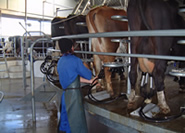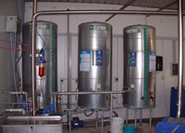Walton Farm Cows
Comparisons
Milking at the Walton farm
(click to enlarge)
Hot water heat recovery with Mahana Blue (click to enlarge)
Northern Hemisphere dairying is largely based on the high input/high output "cut and carry" model. Feed is brought to the animals and their wastes are removed for disposal. While production per cow is often impressively high, it is achieved at very high cost – expensive machinery is required and it is labour and energy intensive. In New Zealand, dairying is based for the most part on a low input/high profit grass-based model. While a pure grass-based system can't match the high production per cow levels of the cut-and-carry agriculture, profitability is achieved through having lower input costs.
The system may be low input but it is definitely not low tech. It still costs money to grow grass and, as with any business, the successful farmer is the one that can manage different combinations of inputs to produce the best profit. Grass-roots technology helps improve the ratio of revenue to costs.
The basis of the New Zealand system is the pasture plants themselves. The development of specialised cultivars of perennial ryegrass, and superior, more nutritious strains of white clover, were breakthroughs which significantly boosted agricultural productivity in New Zealand. (So too was the development of a seed certification system, which provides a quality guarantee for seed buyers.) Subsequently, many specialised pasture cultivars have been developed for specific farming needs. Cultivars of ryegrass, for example, have been developed to cope with drought, hard grazing, and the treading of stock. Clovers and other forage legumes have been specifically bred for low fertility areas, acid soils, and pest and disease resistance.
A new ryegrass cultivar is being trialled on the demonstration farm. Developed by seed company Agricom, the cultivar contains a strain of endophytic fungus – AR37. Ryegrass inoculated with the fungi appears to develop deeper and stronger roots, which help the plant persist for longer in pasture. The presence of the fungus – developed by AgResearch – not only boosts grass production, but also offers natural protection against pasture pests such as root aphids and porina caterpillars as well as Argentine stem weevils, reducing the need for pesticide applications. At the same time AR37 does not release the alkaloids made by wild endophytes, which cause reduced production and sickness (ryegrass staggers) in animals.


